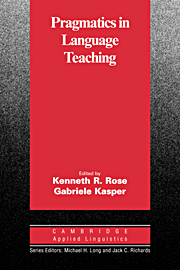Book contents
- Frontmatter
- Contents
- List of contributors
- Series editors' preface
- Preface
- Chapter 1 Pragmatics in language teaching
- I THEORETICAL AND EMPIRICAL BACKGROUND
- II ISSUES IN CLASSROOM-BASED LEARNING OF PRAGMATICS
- III THE EFFECTS OF INSTRUCTION IN PRAGMATICS
- IV THE ASSESSMENT OF PRAGMATIC ABILITY
- Chapter 12 Use of address terms on the German Speaking Test
- Chapter 13 Indicators for pragmatic instruction: Some quantitative tools
- Chapter 14 Pragmatics tests: Different purposes, different tests
- References
- Name index
- Subject index
Chapter 13 - Indicators for pragmatic instruction: Some quantitative tools
Published online by Cambridge University Press: 05 October 2012
- Frontmatter
- Contents
- List of contributors
- Series editors' preface
- Preface
- Chapter 1 Pragmatics in language teaching
- I THEORETICAL AND EMPIRICAL BACKGROUND
- II ISSUES IN CLASSROOM-BASED LEARNING OF PRAGMATICS
- III THE EFFECTS OF INSTRUCTION IN PRAGMATICS
- IV THE ASSESSMENT OF PRAGMATIC ABILITY
- Chapter 12 Use of address terms on the German Speaking Test
- Chapter 13 Indicators for pragmatic instruction: Some quantitative tools
- Chapter 14 Pragmatics tests: Different purposes, different tests
- References
- Name index
- Subject index
Summary
Introduction
With ever-increasing attention to the study of the development and use of pragmatics in a second language, there has arisen a concomitant interest in developing appropriate and valid means for the assessment of pragmatic competence. Although there are established methods for assessing other factors of language production, similar instruments have not yet been developed for the assessment of pragmatics. This chapter will discuss three methods of assessing pragmatic production by Japanese learners of English as a second language. Although the full study involved developing a number of different instruments for assessing pragmatics, only three instruments will be examined here: the written discourse completion test, language lab discourse completion test tape recordings, and role-play of scenarios. These were the instruments that required language production by the examinees, and it was felt that these would provide the most information regarding pedagogical applications of language samples obtained through pragmatic assessment.
A brief review of the project
The initial stage of this project (Hudson, Detmer, & Brown, 1992) involved identifying the nature of the instruments to be used and then determining the variables to be examined. A primary purpose of the study was to examine whether the variables could be used to explain variation in pragmatic performance. The processes of determining the variables were iterative in nature, involving literature reviews and pilot testing of the instruments on small samples of informants. In order to utilize the speech acts most generally researched to date, the speech acts of requests, refusals, and apologies were selected as the speech acts to be investigated.
- Type
- Chapter
- Information
- Pragmatics in Language Teaching , pp. 283 - 300Publisher: Cambridge University PressPrint publication year: 2001
- 19
- Cited by

